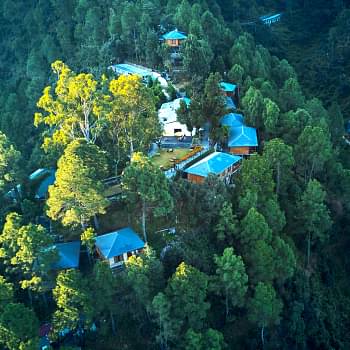February 06, 2020
Top 10 UNESCO World Heritage Sites in India (& Stories Behind Them)

Revati Nargund


View all
140+
Resorts
February 06, 2020

Revati Nargund
India has a rich culture and heritage. Of UNESCO’s World Heritage Sites, over 35 are in India. Club Mahindra brings you the stories behind these historical sites. Read on.
Prince Siddhartha, son of King Shuddhodana, started questioning established religious rites and practices from a tender age. At 16 he set out in search of the truth, which he finally found under a Bodhi tree (Ficus religiosa) at Bodh Gaya. The Mahabodhi (literally the ‘great awakening’) temple is built at the exact spot where the Buddha – as Siddhartha came to be known – found enlightenment. The first temple was built by Emperor Ashoka, followed by many more over the 5th and 6th centuries.
Said to have been built on the ruins of 27 Jain and Hindu temples, the 800-year-old Qutab Minar was built by Qutab-ud-din-Aibak and named after him. Over 72 metres high and with a diameter tapering from 14.32 metres at the bottom to 2.75 metres at the top, the minar (tower) was declared a UNESCO World Heritage site in 1993. The surrounding area contains funerary buildings, notably the Alai Darwaza, and two mosques, including the Quwwat-ul-Islam, the oldest in northern India.
Originally built from white limestone by the Mughal emperor Shah Jahan, the Red Fort or Lal Qila gets its name from the protective red stone walls surrounding it. The British later painted the fort itself red. The fort became Shah Jahan’s new capital when he shifted from Agra to Delhi and he named it Qila-i-Mubarak or the blessed fort. Built between 1638 and 1648, the Red Fort has a history of romance and war. It was here in 1858 that Emperor Bahadur Shah Zafar was tried for treason and exiled to Rangoon (Myanmar).
Located by the banks of the Tungabhadra in hilly terrain formed by granite boulders, the monuments of Hampi are a part of the wider-spread Vijayanagara ruins. Local folklore has it that two young local chieftains, Hakka and Bukka, saw the unusual sight of a hare that was being pursued by their hound suddenly turn around and chase the predator. Vidyaranya, their guru, told them the place is special and asked them to establish their local capital there. The site, which has about 1600 monuments and covers over 40 sq km, is worth a visit for the architecture.
As guides deadpan and tourists look askance, the question in every heart and mind is – why are there erotic sculptures in a temple? One story says a beautiful maiden Hemvati was bathing when she was seduced by the Moon God, who promised her that her son would one day rule over the region. The temples were built in her honour. Another says the sculptures were an effort to rekindle passion among Buddhists. A third story claims that the erotic sculptures are symbolic of leaving your lust outside the place of worship.
Another relic from the Gupta period, these cave temples were rediscovered by the British in the 19th century. It is said that Buddhist and Jain disciples used to reside here and learn at the feet of their gurus. Carved out of whole mountain rock, the artwork at Ajanta is dedicated to Lord Buddha while the Ellora cave complex has murals and sculptures relating to Jain, Hindu, and Buddhist beliefs. They were created under the supervision of several generations of kings, including the Chalukya and Rashtrakuta dynasties.
Built in the 13th century, the Sun Temple at Konarak is said to commemorate the victory of King Narasimhadeva of the Ganga Dynasty over Tughan Khan, a representative of Emperor Nasiruddin Mahmud. Another mythological story goes that Samba, the son of Krishna, contracted leprosy as a result of a curse from Narada. He went to Konarak for penance and cure, where he established an idol of the Sun God which he found in a nearby river.
Consisting of three temples built in the 11th and 12th centuries by the Chola Dynasty, the Chola temples of Brihadeswara, Airavateswara, and Gangaikondacholapuram comprise the three main temples in the complex. The tallest tower at the height of 53 meters has a graceful curve and recessed corners. It was declared a world heritage site in 1987.
Another set of monuments carved from rock, the Mahabalipuram temple was built by the Pallavas in the 7th and 8th centuries. There are about 40 monuments, including the largest open-air bas relief in the world. Locals say the area gained prominence during the reign of Mamalla, hence the alternative name of Mamallapuram. Inscriptions on the walls show that the temple was called the Ratha temple.
Built on the banks of the Yamuna, the fort represented the glory of the Mughals during the 16th to 18th centuries. Constructed of red sandstone, it currently spans 2.5 km in length. The complex is a fusion of Indian and Persian Timurid art. Located in the same city as the Taj Mahal (another world heritage site and one of the seven wonders of the modern world), you can visit both sites in a single trip – one by day and one by night.
Club Mahindra welcomes you to well-appointed resorts in India’s cultural hotspots where you can explore the rich heritage of this great country. With these Club Mahindra reviews, get a sneak peek of what members have to say about the heritage resorts of Club Mahindra!
Mahindra Holidays & Resorts India Ltd. (MHRIL), a part of Leisure and Hospitality sector of the Mahindra Group, offers quality family holidays primarily through vacation ownership memberships and brings to the industry values such as reliability, trust and customer satisfaction. Started in 1996, the company's flagship brand ‘Club Mahindra’, today has over 300,000 members , who can holiday at 140+ resorts in India and abroad.
We use cookies to personalise content and to provide you with an improved user experience.By Continuing to browse this site you consent to the use of cookies.Please visit our cookie policy for further details.

Welcome to ClubMahindra.com In order to provide a personalised experience for you, we use cookies to enable some website functionality. Cookies help us see which articles most interest you; allow you to easily share articles on social media channels; permit us to deliver content personalised to your interests and locations; along with many other site benefits. For more information, please review our Cookie Policy
When you visit any website, it may store or retrieve information on your browser, mostly in the form of cookies. This information might be about you, your preferences or your device and is mostly used to make the site work as you expect it to. The information does not usually directly identify you, but it can give you a more personalized web experience. Because we respect your right to privacy, you can choose not to allow some types of cookies. Click on the different category headings to find out more and change our default settings. However, blocking some types of cookies may impact your experience of the site and the services we are able to offer.
Because we respect your right to privacy, you can choose not to allow some types of cookies and you have the right to withdraw your consent by send a mail to email id [email protected]
These cookies are essential in order to enable you to move around the site and use its features, such as accessing secure areas of the site. Without these cookies, services you have asked for cannot be provided.
These cookies allow us to employ data analytics so we can measure and improve the performance of our site and provide more relevant content to you. These cookies don't collect information that identifies a visitor down to an individual level that is available to us. These cookies are not passing personally identifiable information to any external third party other than in limited cases when we engage a service provider to act on our behalf but who is then unable to use the data for their own purposes.
Performance cookies are generally third-party cookies from vendors we work with or who work on our behalf that collect information about your visit and use of the Club Mahindra website, for instance which pages you visit the most often, and if you get error messages from web pages. These cookies don't collect information that identifies a visitor. All information these cookies collect is anonymous and is only used to improve your overall experience on how the website works. Third party vendors may have access to this data and may use it to improve their overall services and offerings.
Functionality cookies allow a site to remember choices you make (such as your user name, language or the region you are in) and provide more enhanced, personal features. These cookies cannot track your browsing activity on other websites. They don't gather any information about you that could be used for advertising or remembering where you've been on the Internet outside our site.
Third-party advertising and social media cookies are used to (1) deliver advertisements more relevant to you and your interests; (2) limit the number of times you see an advertisement; (3) help measure the effectiveness of the advertising campaign; and (4) understand people's behaviour after they view an advertisement. They are usually placed on behalf of advertising networks with the site operator's permission. They remember that you have visited a site and quite often they will be linked to site functionality provided by the other organization. This may impact the content and messages you see on other websites you visit. If you do not allow these cookies you may not be able to use or see certain these sharing tools content on our website.